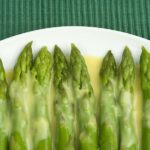Asparagus is a perennial vegetable that will keep on producing for 20 years or longer given the right location and care.
A healthy asparagus patch requires a bit of attention. Rule Number One: Keep ahead of asparagus problems, pests, and diseases.
Here are asparagus growing problems and solutions:
Whole plant problems
Yellow to orange to reddish brown or black pustules on stems and leaves
Asparagus rust is a fungus disease. It is most prevalent in humid regions. Spear tops turn yellow and brown and die back. Plant disease-resistant varieties such as Mary Washington and Martha Washington. Cut down diseased ferns at the crown and destroy them.
Plants and leaves are yellow
Overwateing and poor drainage. Allow soil to dry to a depth of 4 inches before watering again. Check soil pH; add lime if the pH is below 6.5.
Leaves are chewed and slimed
Snails and slugs eat leaves. Collect these pests at night. Set beer traps at soil level to attract and drown snails and slugs.
Plants are weak and spindly; few spears
Harvest was too early or too heavy. Plants must be allowed to store food for the next season before they go dormant. Asparagus should be picked the first year it is planted; the second year harvest for two weeks and the next year for 4 weeks. Stop harvesting when spears are thinner than a pencil.
Spear and shoot problems
Spears are crooked, curved, or malformed
Wind can distort spear growth; protect asparagus from prevailing winds. Too close cultivation will cause spears to be malformed: plant at the recommended distance and be careful when weeding.
Spears are brown or discolored and soft
Frost injury occurs when the crop comes up too early in spring. Discard early spears. Protect crops with floating row covers.
Spears weaken, wilt, yellow, turn brown, and die. Roots have reddish streaks
This can be caused by (1) Fusarium wilt, a soilborne fungus. Destroy infected plants. Solarize the soil. Rotate plantings; or (2) root rot fungi: rotate crops; plant resistant varieties such as Mary Washington; plant in a well-drained area.
Soft spots on tips and shoots; spear bend and turn white or light green
Phytophthora crown and spear rot are common in wet seasons. Dig out and destroy infested plants.
Shoot tips are gnawed or channeled
Black stains on shoots. The Asparagus beetle is a blue-black beetle; the larva is a dark green-gray grub to about ⅛-inch (9mm) long. Remove infected shoots. Wash away eggs, beetles, and larvae with water. Keep the garden free of debris. Use rotenone.
Shoots are white or yellow stippled
Spider mites suck plant juices causing stippling. Spray with water or use insecticidal soap or rotenone.
Shoots are eaten near the soil surface
Cutworms are gray grubs in the soil beneath plants. Use cardboard collars around the stem of plants, pushed 1 inch into the soil. Uncover and handpick grubs.
Asparagus growing success tips
Site and soil
Plant asparagus in well-drained soil with a neutral pH. Choose a site in full sun and sheltered from the wind. Be rid of all weeds then loosen the soil to 12 inches deep. Add 1 inch of aged compost across the bed and 1 pound of bonemeal per 20 square feet.
Planting
Plant healthy, disease-resistant crowns, but before you do soak the crowns in compost tea for 20 minutes. This soaking will ensure that the crowns make good contact with their new home from the get-go. Choose a variety that is resistant to asparagus rust and Fusarium wilt. Male plants will yield better than berry-producing female plants. Plant in spring in 6-inch deep furrows setting crowns 18 to 24 inches apart. As the crowns grow fill in the furrow. You’ll be growing stronger plants.
Care
Keep asparagus beds well-weeded; asparagus suffers from weed competition. Hand weed or use pruners to cut away persistent perennial weeds. Don’t allow weeds to shadow your asparagus. Always keep asparagus evenly watered. Cover the asparagus in winter with straw or compost mulch. Remove the protective mulch in early spring to allow spears to grow.
Harvest
Don’t rush your first harvest. Don’t cut spears the year you plant them. The next year, harvest for 2 weeks when spears are pencil thick. The next year harvest for 4 weeks. The next year’s harvest is for 8 weeks. Don’t cut spears thinner than a pencil. For a longer-than-normal harvest: cut spears for just two weeks in spring then allow 2 or 3 spears from a few of the crowns to mature and produce ferns. These plants will slow in their production for a few weeks while the stalks energize the plant through photosynthesis, then the plants will be ready for 10 more weeks of harvest.
Asparagus articles at Harvest to Table:
How to Harvest and Store Asparagus
Seven Ways to Cook and Serve Asparagus
How to Cook Asparagus with No Recipe
Asparagus Growing Problems Troubleshooting
Asparagus Beetle Organic Pest Control
Related articles:
Vegetable Garden Diseases Problem Solver
Vegetable Garden Organic Weed Control
Garden Planning Books at Amazon:
- Vegetable Garden Almanac & Planner
- Kitchen Garden Grower’s Guide Vegetable Encyclopedia
- Vegetable Garden Grower’s Guide
- Tomato Grower’s Answer Book



